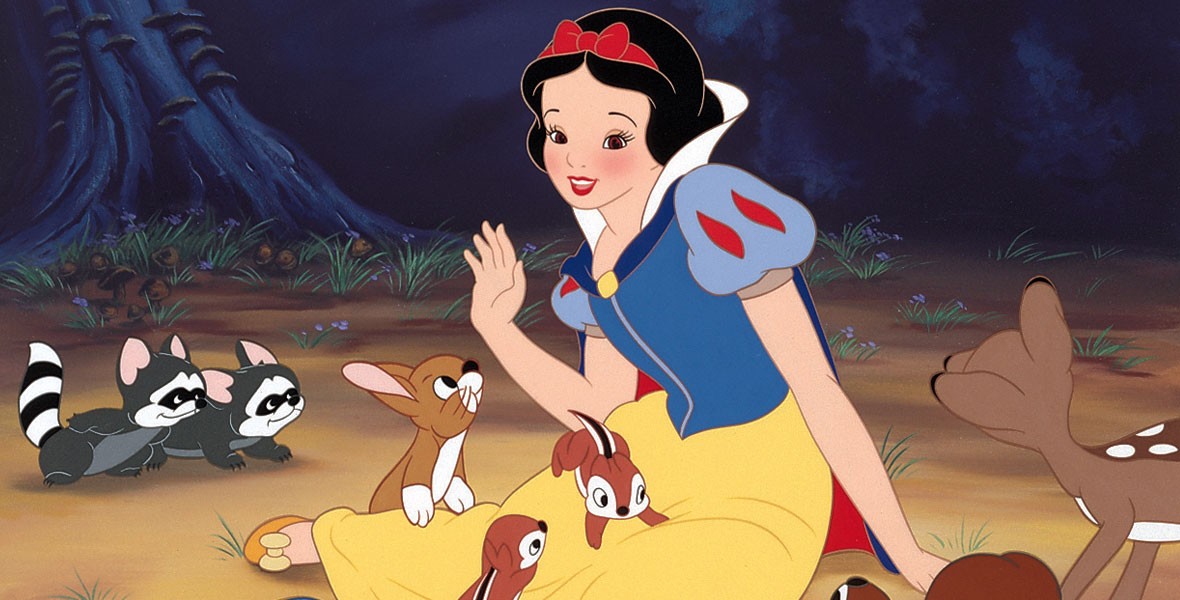Snow White and the Seven Dwarfs (film) A beautiful girl, Snow White, takes refuge in the forest in the house of Seven Dwarfs to hide from her stepmother, the wicked Queen. The Queen is jealous because she wants to be known as the fairest in the land, and Snow White’s beauty surpasses her own. The Dwarfs grow to love their unexpected visitor, who cleans their house and cooks their meals. But one day when they are at their diamond mine, the Queen arrives at the cottage, disguised as an old peddler woman, and she persuades Snow White to bite into a poisoned apple. The Dwarfs, warned by the forest animals, rush home to chase the witch away, but they are too late to save Snow White. They place her in a glass coffin in the woods, and mourn for her. The Prince, who has fallen for Snow White, happens by and awakens her from the wicked Queen’s deathlike spell by “love’s first kiss.” Supervising director was David Hand. Premiered on December 21, 1937, at the Carthay Circle Theater in Hollywood, it was the first animated feature film. The film cost $1.4 million, and featured such classic songs as “Some Day My Prince Will Come,” Heigh Ho,” and “Whistle While You Work.” More than 750 artists worked on the film, which took three years to produce. Of many who auditioned for the voice of Snow White (Walt Disney turned down Deanna Durbin), he chose the young singer Adriana Caselotti. Harry Stockwell, the father of Dean Stockwell, did the voice of the Prince, and many radio and screen personalities were selected for other roles, such as Lucille LaVerne as the Queen and Billy Gilbert as Sneezy. Pinto Colvig (Goofy) did the voices of two of the Dwarfs. Walt had gotten the idea for the film when he was a newsboy in Kansas City, and he saw a major presentation of a silent film version of the story starring Marguerite Clark. The screening was held at the city’s Convention Hall in February 1917, and the film was projected onto a four-sided screen using four separate projectors. The movie made a tremendous impression on the 15-year-old viewer because he was sitting where he could see two sides of the screen at once, and they were not quite in sync.
The film received a special Academy Award in 1939 consisting of one full-size Oscar and seven dwarf Oscars, presented to Walt Disney by Shirley Temple. For a while after its release, the film became the highest-grossing motion picture of all time, until finally surpassed by Gone With the Wind a couple of years later. This statistic is all the more surprising when one realizes that children were paying a dime to get into the theaters in 1937, and the film, of course, had great appeal to that age group. The original worldwide gross was $8.5 million, a figure that would translate into several hundreds of millions in today’s dollars. In England, the film was deemed too scary for children, and those under 16 had to be accompanied by a parent. 83 min. A stage version of the movie played at Radio City Music Hall in New York in 1979. For its 1993 reissue the film was completely restored, being the first ever to be completely digitized by computer, cleaned up, and then printed back to film. The film was reissued eight times, in 1944, 1952, 1958, 1967, 1975, 1983, 1987, and 1993, and released on video in 1994. In 1978, a 16mm release, Snow White: A Lesson in Cooperation, was released for schools. For the television show on the 1983 reissue, see The Fairest of Them All, and for the one for the 50th Anniversary reissue in 1987, see Golden Anniversary of Snow White and the Seven Dwarfs.


